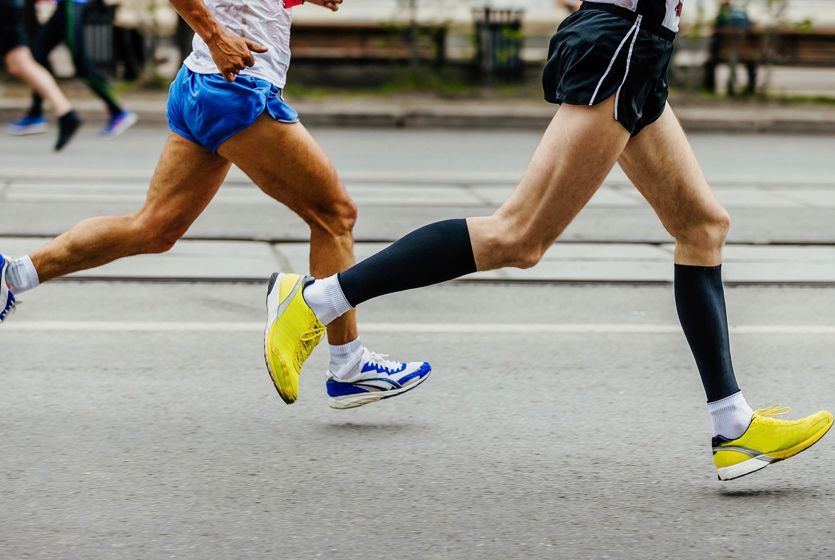Should you’re fortunate, you would possibly effectively undergo your life with out ever actually figuring out something concerning the iliotibial band (or IT band). It’s a kind of components of the physique that quietly does its job with out issues till abruptly, it hurts. And it’s extra more likely to begin hurting in case you’re a runner, as a result of IT band syndrome is without doubt one of the extra widespread operating accidents.
Like many operating accidents, IT band syndrome is normally a results of overuse. Whenever you abruptly improve the quantity or depth of the operating you do and your physique isn’t ready for it, every kind of issues can come up, with achilles tendonitis and plantar fasciitis being different widespread overuse accidents.
Should you’re kicking off a marathon coaching plan, or beginning operating on the whole, it’s essential to construct up your operating step by step to attempt to stop these accidents. Energy coaching for runners may assist to make sure your physique is prepared for the impression of the game.
We spoke to Rebecca Christenson, a specialist musculoskeletal physiotherapist at Pure Sports activities Medication (opens in new tab), for more information on what causes IT band syndrome, how one can keep away from it, and the way you must go about treating it. One spoiler on that final one – foam rolling won’t be your greatest wager.
About Our Skilled
About Our Skilled
Rebecca Christenson
Specialist musculoskeletal physiotherapist
Rebecca Christenson has been a specialist musculoskeletal physiotherapist at Pure Sports activities Medication since 2004, and previous to that labored for each the NHS and in elite sports activities with spells at Tottenham Hotspur FC Academy and Fulham FC Academy.
What’s IT band syndrome?
The IT band runs down the skin of your thigh, extending from the pelvis to only beneath the knee and performs an important position in stabilising the knee throughout operating. Based on Christenson there are two principal theories about what IT band syndrome is: a friction damage or a compression damage.
“Initially it was thought that that band can transfer forwards and backwards because the knee bends and straightens. Beneath that it could be attainable to trigger an space of friction, which is likely to be what we considered ITB friction syndrome. However then, taking a look at some research, there have been questions on whether or not the IT band does transfer precisely like that.”
“One other principle is that there is likely to be some compression created across the lateral facet of the knee [the outer part of the knee], across the tibia [shin bone], and likewise the femur [thigh bone].
Both approach, Christenson says, “it primarily pertains to attainable tissue irritation which can be irritation”.
What are the signs of IT band syndrome?
As with most operating accidents, the first symptom is ache.
“It’s normal to have ache on the skin of the knee,” says Christenson. “It wouldn’t actually trigger ache anyplace else.
“You might need coexisting issues however in case you don’t have ache on the skin of the knee by the knee joint line, you in all probability don’t have ITB syndrome.
“Typically it’s going to cease somebody in the course of the run, however the ache can hit two or three hours later. You’ll arise and discover you’ll be able to’t actually straighten your knee, or that you simply need to hold it straight.”
What causes IT band syndrome?
“It’s positively categorised as an overuse damage,” says Christenson. “Coaching load – the development of that, in addition to depth and quantity – is related.”
Your operating biomechanics may play an enormous half in inflicting IT band syndrome.
“One of many greatest issues – which leads into the potential of the compression principle – is elevated angle of hip adduction, or what you’d name hip drop. That’s whenever you’re operating and the opposite leg drops down in relation to the weight-bearing leg, your pelvis drops in the direction of the weight-bearing leg.”
How do you stop IT band syndrome?
Preserving tabs in your coaching workload and including in some power classes are your first steps for lowering the danger of creating IT band syndrome.
“I will surely say that it’s helpful to have two power classes every week,” says Christenson, “and all the time have no less than at some point off, ideally greater than that.
“What you propose to do the subsequent week ought to relate to what you’ve accomplished within the earlier three weeks. You’ve obtained to have in mind your most up-to-date coaching in addition to your extra long-standing coaching.”
How do you deal with IT band syndrome?
IT band syndrome shouldn’t be an damage to attempt to run by way of.
“Sadly it does usually require day out of operating,” says Christenson. “Three to 6 weeks shouldn’t be unusual.”
“I’ve had sufferers who haven’t adopted recommendation and have gone again earlier. The issue is you’ll be able to usually really feel good strolling fairly rapidly. You might need ache strolling for 2 or three days and then you definitely would possibly really feel good and resolve to run every week later. In my expertise that does not usually work. Even in case you really feel good strolling, it usually requires a higher time frame out of operating to scale back that irritation.”
While you’re resting you must take the time to look at your coaching load and likewise your operating biomechanics. And whenever you do get again to operating it’s important to construct up step by step, reasonably than going straight in with the coaching workload you had earlier than the damage.
Can foam rolling assist?
Unhealthy information for followers of self-myofascial launch: it’s in all probability not the tonic required on your IT band syndrome.
“I’d say the proportion of sufferers the place a decent ITB is the principle driver of their signs is extremely low – lower than 5%,” Christenson says. Since a foam curler releases tightness it received’t be of a lot use.
Actually, overuse of the froth curler can have a detrimental impact.
“Typically I’ll have sufferers who massively overuse it and trigger themselves irritation increased up within the IT band,” says Christenson.
How do you’re employed in your operating biomechanics?
It’s difficult to repair any biomechanics points with out an professional at hand, however power work within the health club will help, particularly in case you do it on one leg.
“Lots of people will go to the health club and do leg presses and perhaps squats however they’re by no means on one leg,” says Christenson.
“Single-leg workout routines which are aimed on the glutes and the quads, in all probability with some resistance, are fairly essential in case you’re a runner.”
Strive single-leg squats for starters and examine your biomechanics with a mirror.
“You’re in search of good alignment,” says Christenson. “Broadly you need the pelvis to be stage, and also you need your knee to be over your foot reasonably than deviating inwards or outwards.”
You could find extra helpful strikes, unilateral and in any other case, in our information to leg workout routines for runners.
If you’re frightened about your biomechanics is it greatest to see an professional?
“I believe it’s actually arduous to self-manage,” says Christenson. “Except what you’re beginning with it’s arduous to repair.”
We’ve tried a operating biomechanics screening and located it helpful. Nevertheless, if it’s not an choice for the time being for no matter motive all shouldn’t be misplaced. Should you’re constant together with your power coaching to assist your operating, your unhealthy biomechanics would possibly by no means meet up with you.
“Even somebody with unhealthy biomechanics,” says Christenson, “in the event that they’re wise with their coaching and so they’re sturdy I believe they’ll get away with loads.”






